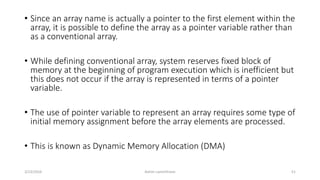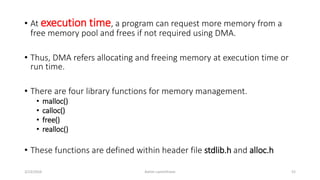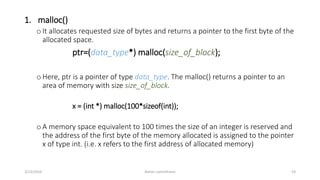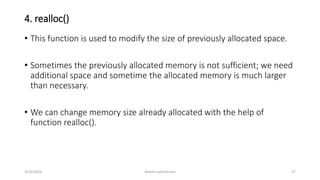The document explains computer memory, specifically RAM, including its structure and how variables are allocated within it. It introduces pointers, their types (including void pointers and null pointers), pointer arithmetic, and the distinction between single and double pointers, along with practical examples in C programming. Additionally, it covers arrays of pointers and the relationship between arrays and pointers in C.
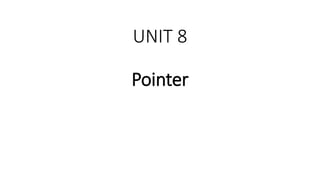

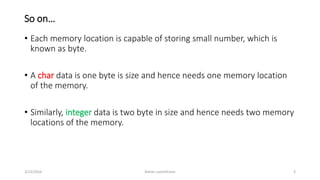



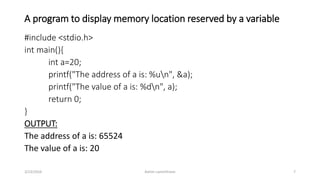


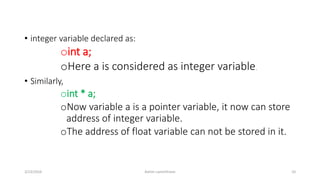

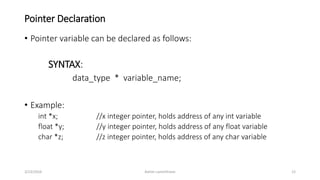


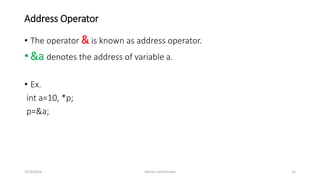
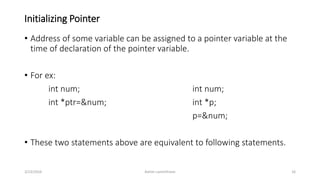

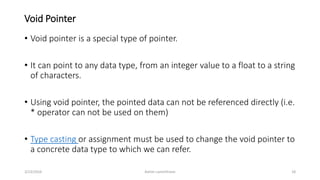



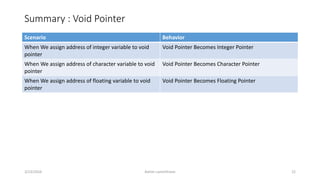


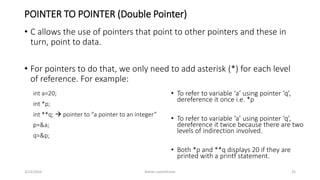


![Array Of Pointers
• An array of pointers can be declared as
data_type *pointer_name[size];
• For ex:
int *p[10];
• This declares an array of 10 pointers, each of which points to an integer. The first
pointer is called p[0], the second is p[1] and so on up to p[9].
• Initially, these pointers are uninitialized and they can be used as below.
int a=10, b=100, c=1000;
p[0]=&a;
p[1]=&b;
p[2]=&c; and so on.
3/23/2016 Ashim Lamichhane 28](https://image.slidesharecdn.com/pointer-160323210326/85/Unit-8-Pointers-28-320.jpg)
![Relationship between 1-D array and pointer
• Array name by itself is an address or pointer.
• It points to the address of the first element(0th element of an array)
• If x is 1D array, the address of the first element can be expressed as
&x[0] or as x.
• Similarly address of second array element can be written as &x[1]or
x+1.
• In general, address on an array element i can be expressed as &x[i]
or x+i
3/23/2016 Ashim Lamichhane 29](https://image.slidesharecdn.com/pointer-160323210326/85/Unit-8-Pointers-29-320.jpg)
![3/23/2016 Ashim Lamichhane 30
• In general address of array element i can be expressed as &x[i] or x+i
• x[i] and *(x+i) both represents represents the content of the address.
Array x
Address of first
array element
can be expressed as
&x[0] or simply x
x[0] x[1] x[2] x[3]
Array x
Address of second
array element
can be expressed as
&x[1] or simply x+1
x[0] x[1] x[2] x[3]](https://image.slidesharecdn.com/pointer-160323210326/85/Unit-8-Pointers-30-320.jpg)
![#include <stdio.h>
int main(){
int x[5]={20,40,60,80,100},k;
printf("narray element ttelements value ttaddressn");
for(k=0;k<5;k++){
printf("x[%d]ttt%dttt%pn",k,*(x+k),x+k );
}
}
array element elements value address
x[0] 20 0x7fff5bb0bbb0
x[1] 40 0x7fff5bb0bbb4
x[2] 60 0x7fff5bb0bbb8
x[3] 80 0x7fff5bb0bbbc
x[4] 100 0x7fff5bb0bbc0
3/23/2016 Ashim Lamichhane 31
To display array element with their address using array name as a pointer
OUTPUT
• Element k acts as the element number( 0,1,2,3,4)
• x acting array is added with k i.e k is added with the address of first element, it points to the consecutive
memory location.
• Thus &x[k] is same as *(x+k)](https://image.slidesharecdn.com/pointer-160323210326/85/Unit-8-Pointers-31-320.jpg)
![/* WAP to calculate average marks of 10 students in a subject using pointer*/
#include <stdio.h>
int main(void){
float marks[10],sum=0;
int i;
float avg;
printf("Enter marks of 10 students: ");
for(i=0;i<10;i++){
scanf("%f",marks+i);
sum+=*(marks+i);
}
avg=sum/10;
printf("nThe average is=%fn", avg);
}
3/23/2016 Ashim Lamichhane 32
marks+0
marks+1
marks+2
marks+3
marks+4](https://image.slidesharecdn.com/pointer-160323210326/85/Unit-8-Pointers-32-320.jpg)
![Pointers and 2-D Arrays
• A two dimensional array is actually a collection of one dimensional arrays, each
indicating a row (i.e. 2-D array can be thought as one dimensional array of rows).
• It is stored in memory in the row form. For ex.
a=
3/23/2016 Ashim Lamichhane 33
1 2 3
4 5 6
7 8 9
• Is stored in the row major order in memory as illustrated below
1 2 3 4 5 6 7 8 9
a[0][0] a[0][1] a[0][2] a[1][0] a[1][1] a[1][2] a[2][0] a[2][1] a[2][2]
65500 65502 65504 65506 65508 65510 65512 65514 65516](https://image.slidesharecdn.com/pointer-160323210326/85/Unit-8-Pointers-33-320.jpg)
![Syntax for declaration of 2-D array
• data_type (*ptr_var)[size2];
• Instead of data_type array[size1][size2];
• Ex: Suppose x is a two dimensional integer array having 4 rows and 5 columns. We declare
x as
int (*x)[5];
rather than
int x[4][5];
• x points to the first 5 element array, which is actually first row of the two dimensional
array.
• Similarly x+1 points to the second 5 element array, which is the second row of the two
dimensional array
3/23/2016 Ashim Lamichhane 34](https://image.slidesharecdn.com/pointer-160323210326/85/Unit-8-Pointers-34-320.jpg)
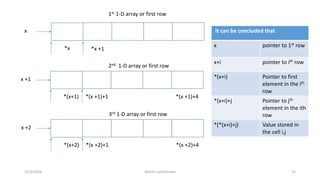
![and
Thus in 2-D array,
&x[0][0] Is same as *x or *(x+0)+0
&x[0][1] Is same as *x +1 or *(x+0)+1
&x[2][0] Is same as *x +2 or *(x+2)+0
&x[2][4] Is same as *(x+2)+4
3/23/2016 Ashim Lamichhane 36
Thus in 2-D array,
&x[0][0] Is same as **x or *(*(x+0)+0)
&x[0][1] Is same as *(*x +1) or*( *(x+0)+1)
&x[2][0] Is same as *(*x +2) or *(*(x+2)+0)
&x[2][4] Is same as *(*(x+2)+4)](https://image.slidesharecdn.com/pointer-160323210326/85/Unit-8-Pointers-36-320.jpg)
![OUTPUT
/* Illustration of 2D array representation in Memory */
#include <stdio.h>
int main(void){
int p[2][3]={{1,2,3},{4,5,6}};
printf("p=%p p+1=%p",p,p+1);
printf("*p=%p *(p+1)=%p ",*p,*(p+1));
printf("*(p+0)+1=%p *(p+1)+1=%p",*(p+0)+1,*(p+1)+1);
printf("*(*(p+0)+1)=%d *(*(p+1)+1)=%d",*(*(p+0)+1),
*(*(p+1)+1));
}
p=0x7fff51c9dbd0
*p=0x7fff51c9dbd0
*(p+0)+1=0x7fff51c9dbd4
*(*(p+0)+1)=2
p+1=0x7fff51c9dbdc
*(p+1)=0x7fff51c9dbdc
*(p+1)+1=0x7fff51c9dbe0
*(*(p+1)+1)=5
3/23/2016 Ashim Lamichhane 37](https://image.slidesharecdn.com/pointer-160323210326/85/Unit-8-Pointers-37-320.jpg)
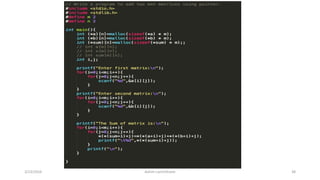


![• One pointer can be subtracted from other pointer provided they point
to elements of same array. For ex:
int main(void){
int a[]={45,89,54,29},*pf,*p1;
p1=a;
pf=a+2;
printf("So pf-p1=%ldn",pf-p1 );
}
OUTPUT: ???
3/23/2016 Ashim Lamichhane 41](https://image.slidesharecdn.com/pointer-160323210326/85/Unit-8-Pointers-41-320.jpg)
![• Here p1, points address of a[0] i.e. 65518 and pf points address to next
second block i.e. 65522.
• The difference between pf and p1 means number of memory blocks
for their type between addresses pointed by them i.e. 2 in this case
3/23/2016 Ashim Lamichhane 42
a[0] a[1] a[2] a[3]
65518 65520 65522 65524
45 89 54 29](https://image.slidesharecdn.com/pointer-160323210326/85/Unit-8-Pointers-42-320.jpg)
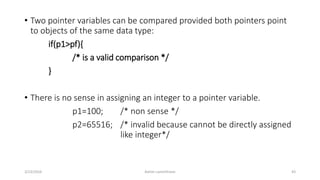




![String And Pointer
• As strings are arrays and arrays are closely connected with pointers, we can
say that string and pointers are closely related.
char name[5]=“shyam”;
• As the string variable name is an array of characters, it is a pointer to the
first character of the string and can be used to access and manipulate the
characters of the string.
• When a pointer to char is printed in the format of a string, it will start to
print the pointer character and then successive characters until the end of
string is reached.
• Thus name prints “shyam”, name+1 prints “hyam”, name+2 prints “yam”
and so on.
3/23/2016 Ashim Lamichhane 48](https://image.slidesharecdn.com/pointer-160323210326/85/Unit-8-Pointers-48-320.jpg)
![Dynamic memory allocation (DMA)
• The process of allocating and freeing memory at run time is known as
dynamic memory allocation.
• This reserves the memory required by the program and returns valuable
resources to the system once the use of reserved space is utilized.
• Though arrays can be used for data storage, they are of fixed size.
#define m 5
int main(void){
int x[m];
printf("%lun",sizeof(x));
}
3/23/2016 Ashim Lamichhane 49](https://image.slidesharecdn.com/pointer-160323210326/85/Unit-8-Pointers-49-320.jpg)

